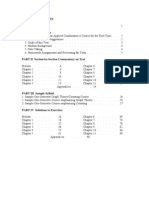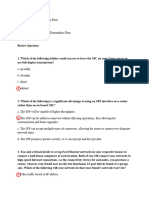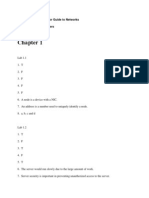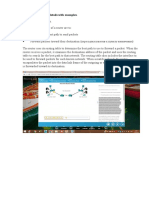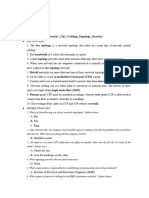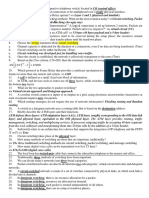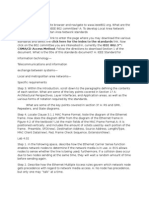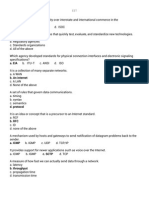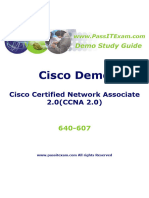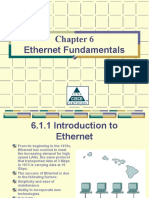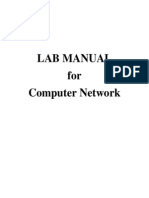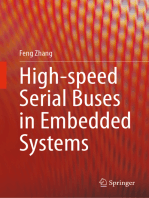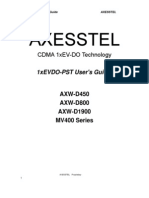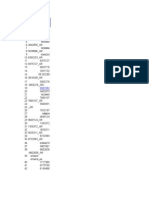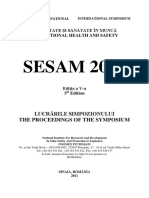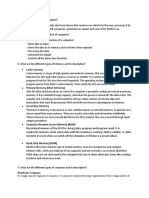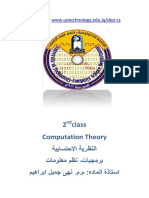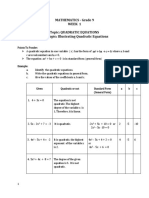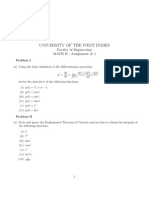0 ratings0% found this document useful (0 votes)
26 viewsCh3 Ethernet Basic
Ch3 Ethernet Basic
Uploaded by
Thế Vinh PhanThe document discusses Ethernet networking concepts including key terms, Ethernet frame structure, CSMA/CD, switches vs hubs, Ethernet cable types, and the spanning tree protocol. It includes explanations, diagrams, multiple choice questions and lab exercises on these topics.
Copyright:
© All Rights Reserved
Available Formats
Download as PDF, TXT or read online from Scribd
Ch3 Ethernet Basic
Ch3 Ethernet Basic
Uploaded by
Thế Vinh Phan0 ratings0% found this document useful (0 votes)
26 views5 pagesThe document discusses Ethernet networking concepts including key terms, Ethernet frame structure, CSMA/CD, switches vs hubs, Ethernet cable types, and the spanning tree protocol. It includes explanations, diagrams, multiple choice questions and lab exercises on these topics.
Original Title
Ch3_Ethernet_Basic
Copyright
© © All Rights Reserved
Available Formats
PDF, TXT or read online from Scribd
Share this document
Did you find this document useful?
Is this content inappropriate?
The document discusses Ethernet networking concepts including key terms, Ethernet frame structure, CSMA/CD, switches vs hubs, Ethernet cable types, and the spanning tree protocol. It includes explanations, diagrams, multiple choice questions and lab exercises on these topics.
Copyright:
© All Rights Reserved
Available Formats
Download as PDF, TXT or read online from Scribd
Download as pdf or txt
0 ratings0% found this document useful (0 votes)
26 views5 pagesCh3 Ethernet Basic
Ch3 Ethernet Basic
Uploaded by
Thế Vinh PhanThe document discusses Ethernet networking concepts including key terms, Ethernet frame structure, CSMA/CD, switches vs hubs, Ethernet cable types, and the spanning tree protocol. It includes explanations, diagrams, multiple choice questions and lab exercises on these topics.
Copyright:
© All Rights Reserved
Available Formats
Download as PDF, TXT or read online from Scribd
Download as pdf or txt
You are on page 1of 5
The Vinh Phan
Dr. Linh Tran
CTS1134 - Network+
17th March 2024
Network+_Ch3_Ethernet_Basic_Practice
● Key Terms Quiz
1. MAC address
2. pad
3. half-duplex
4. type
5. preamble
6. hub
7. bridging loop
8. CRC
9. 10BaseT
10. fiber-optic
● Multiple Choice Quiz
1. A. One end is TIA/EIA 568A; the other end is TIA/EIA 568B.
2. B. Carrier sense, Multiple access, Collision detection
3. D. A collision occurred.
4. A. Collision domain
5. D. IEEE 802.3
6. D. UTP
7. A. It gives the receiving NIC time to realize a frame is coming and to know when the frame
starts.
8. B. Uplink port on one switch; regular port on the other switch.
9. B. To attach an RJ-45 connector to a UTP cable
10. B. Maximum distance between hub and node of 100 feet
11. C. Maximum of 1024 nodes per hub
12. B. Destination MAC address
13. D. Pad
14. A. STP
15. B. SAT
● Essay Quiz
1. Frames facilitate data movement in a network by providing structure and organization to
the data. They encapsulate data into manageable units, ensuring efficient transmission and
delivery. Additionally, frames include control information such as source and destination
addresses, aiding in proper routing and delivery across the network.
2. CSMA/CD stands for Carrier Sense Multiple Access with Collision Detection. Carrier
Sense (CS) involves nodes checking the network for traffic before transmitting to avoid
collisions. Multiple Access (MA) allows multiple nodes to share the same medium. Collision
Detection (CD) enables nodes to detect collisions when they occur, prompting them to take
corrective action such as retransmitting data.
3. A hub is a networking device that connects multiple devices in a network, acting as a
central point for data transmission. However, hubs operate at the physical layer of the OSI
model and lack intelligence, leading to limitations such as inefficient data forwarding and
susceptibility to collisions. In contrast, a switch operates at the data link layer and overcomes
hub limitations by intelligently forwarding data only to the intended recipient, thereby
reducing collisions and improving network performance.
Network+_Ch3_Ethernet_Basic_Lab
● Lab Exercise 3.01: The 802.3 Working Group and Standards
1. Step 1
Answer : The IEEE 802 LAN / MAN Standards Committee develops and maintains
networking standards and recommended practices for local , metropolitan , and other area networks ,
using an open and accredited process , and advocates them on a global basis .
2. Step 2
Answer: 2018
3. Step 3
Answer: the key points are the circuitry and how it used and defined it also shows the
diagrams and instructions on safety and much more
Answer: it explains how the circuitry and how it works.
4. Step 4
Answer: The Ethernet frame consists of several key components:
1. Preamble: A 7-byte sequence of alternating 1s and 0s, followed by a Start Frame
Delimiter (SFD), to signal the start of a frame.
2. Destination and Source MAC Addresses: Each 6 bytes long, identifying the
intended recipient and the sender, respectively.
3. Type Field: 2 bytes storing information about the upper layer protocol.
4. Data and Pad: This field carries the actual data encapsulated from the upper layer,
with a size limit ranging from 46 to 1500 bytes. Padding is added if necessary.
5. Frame Check Sequence (FCS): A 4-byte value generated by the sender using a
CRC algorithm to check for frame integrity upon receipt.
Overall, the Ethernet frame structure ensures efficient data transmission and integrity
verification within the network.
● Lab exercise 3.02: CSMA/CD - Past and Present
1. Step 1
Answer : a CSMA CD is used as a half - duplex because the half duplex uses gigabit Ethernet
with CSMA / CD to have a collision of results when a frame sent from one end of the network collides
with another frame .
2. Step 2
Answer: it is not used simply because the connection between a host and a NIC and a switch
is a full duplex so the CSMA/CD is not needed because no collision can occur.
3. Step 3
Answer: duplex mismatch is a condition that occurs when two devices communicate over an
ethernet link and do not agree on the duplex mode of the ethernet connection between them. As for
what the effects are, the devices can't properly negotiate their connection so they cause constant
packet loss.
● Lab exercise 3.03: Building an Ethernet Patch Cable
● Lab exercise 3.04: Understanding the Differences between Cat 5E and Cat 6/6A
1. Step 1
Answer: You should use Cat 6/6A for future installations, instead of Cat 5e because Cat 6/6a
has a better performance and has fewer errors.
2. Step 2
Answer: Because it is difficult to replace cabling inside walls, in duct under floors and other
difficult places to access. It will be very expensive to pull out category 5e cabling at a later time to
install category 6 cabling.
3. Step 3
Answer: No, you shouldn’t install Cat 5e.
4. Step 4
Answer: Cat 6/6A will benefit in the home because it will support higher internet access
speeds.
5. Step 5
Answer: Cat 7, 7A, and 8 cables are not preferred replacements for Cat 6/6A due to higher
costs, limited compatibility, and the sufficient performance of Cat 6A for most applications.
● Lab exercise 3.05: Enhancing the Performance of Ethernet Networks
1. Step 1:
Answer: Switch Configuration: Central switch connected to two second-level switches, each
with a computer attached. Connectivity between the computers confirmed.
2. Step 2
Answer: Function of a Switch: Switches forward data packets within a network based on
MAC addresses, creating direct communication paths between devices, thereby enhancing network
efficiency.
3. Step 3
Answer: Advantages of Switches Over Hubs: Switches offer dedicated bandwidth, improved
security through separate collision domains, support for full-duplex communication, scalability, and
reduced network congestion compared to hubs, leading to better network performance and
management.
● Lab exercise 3.06: Exploring the spanning tree protocol (STP)
1. Step 1:
Answer: Clause 17 title: "Generic Attribute Registration Protocol (GARP)"
2. Step 2:
Answer: Cisco website URLs for Spanning Tree Protocol:
- https://www.cisco.com/c/en/us/support/docs/lan-switching/spanning-tree-protocol/12013-4.html
- https://www.cisco.com/c/en/us/support/docs/lan-switching/spanning-tree-protocol/19120-122.html
3. Step 3:
Answer: Spanning Tree Protocol (STP) ensures loop-free Ethernet networks by blocking
redundant paths and dynamically adjusting forwarding paths based on changes in the network
topology, ensuring stability and resilience.
Lab Analysis
1. The difference between half-duplex and full duplex is half duplex you can send and receive
data, but not at the same time. Full duplex you can send and receive at the same time.
2. The basic function of the FCS is to enable Ethernet nodes to recognize errors. The algorithm
used for the FCS is called CRC (cyclic redundancy check).
3. The pins that are connected are pins 1,2 and 3,6 on the RJ connector. Because the crossover
cable sending and receiving pairs are reversed so that the switches can communicate with each
other.
4. MAC addresses are found in Ethernet frames.
5. Tools I would recommend him to use to build and test the cables are crimpers and to test a
cable tester
Key term quiz
1. You’d connect a PC to a switch with a(n) straight-through cable.
2. STP (Spanning Tree Protocol) prevents switches that have been mistakenly connected back into
themselves, forming a bridging loop, from flooding the network with damaged packets.
3. A(n) crossover cable is created when you construct a UTP cable using the TIA/EIA 568A
standard for one end of the cable, and the other TIA/EIA 568B standard for the other end of the cable.
4. The Ethernet standard developed by Xerox was eventually handed over to the IEEE 802.3 working
group, who continue to manage the standard today.
5. Ethernet no longer needs to use CSMA/CD, because modern devices use a method called
full-duplex, which allows simultaneous bidirectional communication between two sides of a
connection.
You might also like
- Applied Combinatorics 5th Edition by Tucker Instructor's ManualDocument93 pagesApplied Combinatorics 5th Edition by Tucker Instructor's ManualZahaib Akhtar100% (5)
- Unit IIIDocument11 pagesUnit IIIJayprakash DuveNo ratings yet
- CN Lab File-1Document51 pagesCN Lab File-1Shreya VermaNo ratings yet
- Chapter 4-6 Review - Set 2: Divine Word UniversityDocument9 pagesChapter 4-6 Review - Set 2: Divine Word UniversityIshmael FaruNo ratings yet
- Basic QuestionsDocument6 pagesBasic QuestionsJowel RanaNo ratings yet
- Examen 4-7Document10 pagesExamen 4-7Jhon RojasNo ratings yet
- Comptia Network+ Study SheetDocument30 pagesComptia Network+ Study SheetDan Sheets100% (5)
- SYN CH - 1 and 2Document20 pagesSYN CH - 1 and 2IG TECHNo ratings yet
- CN Lab File - 2024Document80 pagesCN Lab File - 2024imamsahil202No ratings yet
- Answers To The "Do I Know This Already?" Quizzes: Appendix CDocument24 pagesAnswers To The "Do I Know This Already?" Quizzes: Appendix CAbu AsimNo ratings yet
- Answers To The "Do I Know This Already?" Quizzes: Appendix CDocument24 pagesAnswers To The "Do I Know This Already?" Quizzes: Appendix Clashanj2No ratings yet
- Computer NetworkDocument27 pagesComputer Networkanoopsam115No ratings yet
- CN Theory Assignment 3 SolDocument8 pagesCN Theory Assignment 3 SolfaujiantonyNo ratings yet
- Unit 2 CNDocument35 pagesUnit 2 CNmsk.official321No ratings yet
- To Identify Where The Frame Starts and Ends To Distinguish Data Bits From Control BitsDocument6 pagesTo Identify Where The Frame Starts and Ends To Distinguish Data Bits From Control BitsLeonardo Alberto Conde TorresNo ratings yet
- DCCN Lab ManualDocument35 pagesDCCN Lab ManualSandeep Santhosh100% (1)
- CN FileDocument32 pagesCN Filehkaushik467No ratings yet
- OSI Model QuestionsDocument5 pagesOSI Model QuestionsNicholas Martin100% (1)
- CCNA Crash Course Day 01Document198 pagesCCNA Crash Course Day 01JJohnny100% (1)
- 04 - Networking TechnologiesDocument23 pages04 - Networking TechnologiesTABLE OF WISDOMNo ratings yet
- Capter 4Document8 pagesCapter 4newNo ratings yet
- IntrebariDocument18 pagesIntrebarimick65No ratings yet
- CN 04Document3 pagesCN 04Aashman VermaNo ratings yet
- Networking Interview Questions and Answers PDFDocument13 pagesNetworking Interview Questions and Answers PDFwazad asmaNo ratings yet
- CCNA Training Basic QuestionsDocument9 pagesCCNA Training Basic QuestionsNgô cao cườngNo ratings yet
- Wired Lans: 1. IEEE Project 802Document18 pagesWired Lans: 1. IEEE Project 802sarala deviNo ratings yet
- EE-379 Embedded Systems and Applications: Introduction To EthernetDocument25 pagesEE-379 Embedded Systems and Applications: Introduction To EthernetJohn HowardNo ratings yet
- Salsabila Ramadhani Putri - Tugas 6Document6 pagesSalsabila Ramadhani Putri - Tugas 6dzulaji2024No ratings yet
- Sol ch12Document4 pagesSol ch12Kaycey JoNo ratings yet
- ch6 Network PDFDocument28 pagesch6 Network PDFomerNo ratings yet
- Maseno University: Schoo of Mathematics Statistics and Actuarial Science BSC. Mathematics & Computer ScienceDocument8 pagesMaseno University: Schoo of Mathematics Statistics and Actuarial Science BSC. Mathematics & Computer SciencewertNo ratings yet
- Ethernet Networks: 1: CSMA/CD OperationsDocument4 pagesEthernet Networks: 1: CSMA/CD OperationsPriya SharmaNo ratings yet
- CCNA 1 v6 Chapter 4Document8 pagesCCNA 1 v6 Chapter 4Webber JonxNo ratings yet
- V7 Cap 4-7Document6 pagesV7 Cap 4-7ask_gabyNo ratings yet
- Arcnet 2Document11 pagesArcnet 2Boris BarzalloNo ratings yet
- CN University Paper Solution 2018-19Document22 pagesCN University Paper Solution 2018-19Khushi aroraNo ratings yet
- Chapter - 4 - 2022 - EditedDocument46 pagesChapter - 4 - 2022 - EditedGeez DesignNo ratings yet
- Network+ Lab Manual For Guide To Networks Review Question AnswersDocument39 pagesNetwork+ Lab Manual For Guide To Networks Review Question Answersjon12345jonNo ratings yet
- 100 CiscoDocument93 pages100 CiscoulugbekNo ratings yet
- Ch2 Cabling TopologyDocument7 pagesCh2 Cabling TopologyThế Vinh PhanNo ratings yet
- Carrier and Traditional EthernetDocument6 pagesCarrier and Traditional EthernetDANIELGONFANo ratings yet
- Ôn ThiDocument16 pagesÔn ThiAnh NguyễnNo ratings yet
- Computer Networks Lab ManualDocument61 pagesComputer Networks Lab Manualjenisha100% (2)
- Chapter 4 LabsDocument4 pagesChapter 4 LabsCute_RioluNo ratings yet
- BCSE2052 - Lab Manual - StudentVerDocument63 pagesBCSE2052 - Lab Manual - StudentVerAniket SharmaNo ratings yet
- LAN and Ethernet Basics - Deepak George: OSI Network LayersDocument12 pagesLAN and Ethernet Basics - Deepak George: OSI Network LayersUseful Videos DevotionalNo ratings yet
- ESTDocument29 pagesESTRoland AcejoNo ratings yet
- Capitulo 5 EthernetDocument16 pagesCapitulo 5 EthernetRafael SilveraNo ratings yet
- CHAPTER CiscoDocument24 pagesCHAPTER CiscoturalleyvazliNo ratings yet
- Introducing To NetworkingDocument5 pagesIntroducing To Networkinggheorghe_tiberiu96No ratings yet
- Q Chap8Document16 pagesQ Chap8risenz123No ratings yet
- Ethernet 03 PDFDocument7 pagesEthernet 03 PDFrimar027No ratings yet
- Broadcast Communication Networks: Version 2 CSE IIT, KharagpurDocument13 pagesBroadcast Communication Networks: Version 2 CSE IIT, Kharagpurdarebusi1No ratings yet
- Cisco Demo: Cisco Certified Network Associate 2.0 (CCNA 2.0)Document8 pagesCisco Demo: Cisco Certified Network Associate 2.0 (CCNA 2.0)isaac muthusiNo ratings yet
- Introduction To Networks Version 70 ITNv7 Practice Final Exam AnswersDocument27 pagesIntroduction To Networks Version 70 ITNv7 Practice Final Exam AnswersTemam MohammedNo ratings yet
- CCNA1 Mod 6Document28 pagesCCNA1 Mod 6KlokanNo ratings yet
- CN Lab Manual VISemDocument34 pagesCN Lab Manual VISemAlwin RsNo ratings yet
- AxesstelPst EVDO ManualDocument39 pagesAxesstelPst EVDO Manualdilligas1234No ratings yet
- LG 42LM7600-CA CH - LC22E-tv PDFDocument49 pagesLG 42LM7600-CA CH - LC22E-tv PDFRonald CastellarNo ratings yet
- How To Set Up A NAT Router On Ubuntu Server 16Document5 pagesHow To Set Up A NAT Router On Ubuntu Server 16azarNo ratings yet
- White Collar CrimeDocument49 pagesWhite Collar CrimeAnjaniNo ratings yet
- Land Rover Freelander Owners Manual 2004 PDFDocument262 pagesLand Rover Freelander Owners Manual 2004 PDFSasa SNo ratings yet
- Wms PatchesDocument8 pagesWms PatchesAhmed AdelNo ratings yet
- Ableton File ManagementDocument3 pagesAbleton File ManagementDan JosephNo ratings yet
- Line Conventions and Lettering: ASME Y14.2-2014Document5 pagesLine Conventions and Lettering: ASME Y14.2-2014John Paulo Guerta SerranoNo ratings yet
- LIDAR Lite Laser DatasheetDocument2 pagesLIDAR Lite Laser DatasheetCruz Manuel PerezNo ratings yet
- OOP's (CS3391)Document17 pagesOOP's (CS3391)stevecansesNo ratings yet
- Bulk Modulus of Air Content Oil in A Hydraulic CylinderDocument11 pagesBulk Modulus of Air Content Oil in A Hydraulic CylinderCamilo ManriqueNo ratings yet
- Isaac Asimov An Easy Introduction To The Slide RuleDocument164 pagesIsaac Asimov An Easy Introduction To The Slide Ruleedwrite5470100% (1)
- Volum Sesam 2011Document381 pagesVolum Sesam 2011Teicu Oliver100% (1)
- Manoj Mathur ResumeDocument2 pagesManoj Mathur ResumeManoj MathurNo ratings yet
- 8619Document177 pages8619Aimen BukhariNo ratings yet
- Industrial Machinery & Tools Corporation: ProfileDocument7 pagesIndustrial Machinery & Tools Corporation: ProfileGopi KrishnaNo ratings yet
- ComfunDocument4 pagesComfunMarc BuenaflorNo ratings yet
- 2Document5 pages2Tushar BorkarNo ratings yet
- PhamCongTrung CMU SE 433 SCDocument5 pagesPhamCongTrung CMU SE 433 SCPhạm TrungNo ratings yet
- Theory CompDocument76 pagesTheory CompOthman AhmedNo ratings yet
- Rdbms NoteDocument3 pagesRdbms Noteram5584100% (3)
- Mathematics - Grade 9 Week 1 Topic: Quadratic Equations Sub Topic: Illustrating Quadratic EquationsDocument13 pagesMathematics - Grade 9 Week 1 Topic: Quadratic Equations Sub Topic: Illustrating Quadratic EquationsCleo VillanuevaNo ratings yet
- Renewable Energy Course PaperDocument24 pagesRenewable Energy Course PaperAminul HoqueNo ratings yet
- Critical SparesDocument13 pagesCritical Sparesanurag_pugaliaaNo ratings yet
- Shailesh ResumeDocument2 pagesShailesh ResumeShailesh SharmaNo ratings yet
- Chronotron ProDocument14 pagesChronotron ProClay AldebaranNo ratings yet
- Assignment 1 Engineering MathsDocument2 pagesAssignment 1 Engineering MathsSteven PalmerNo ratings yet
- Ijciet 08 11 106Document8 pagesIjciet 08 11 106AI tailieuNo ratings yet
- Module 1: Platform Development Basics: Salesforce DeveloperDocument3 pagesModule 1: Platform Development Basics: Salesforce Developervijay kumarNo ratings yet
